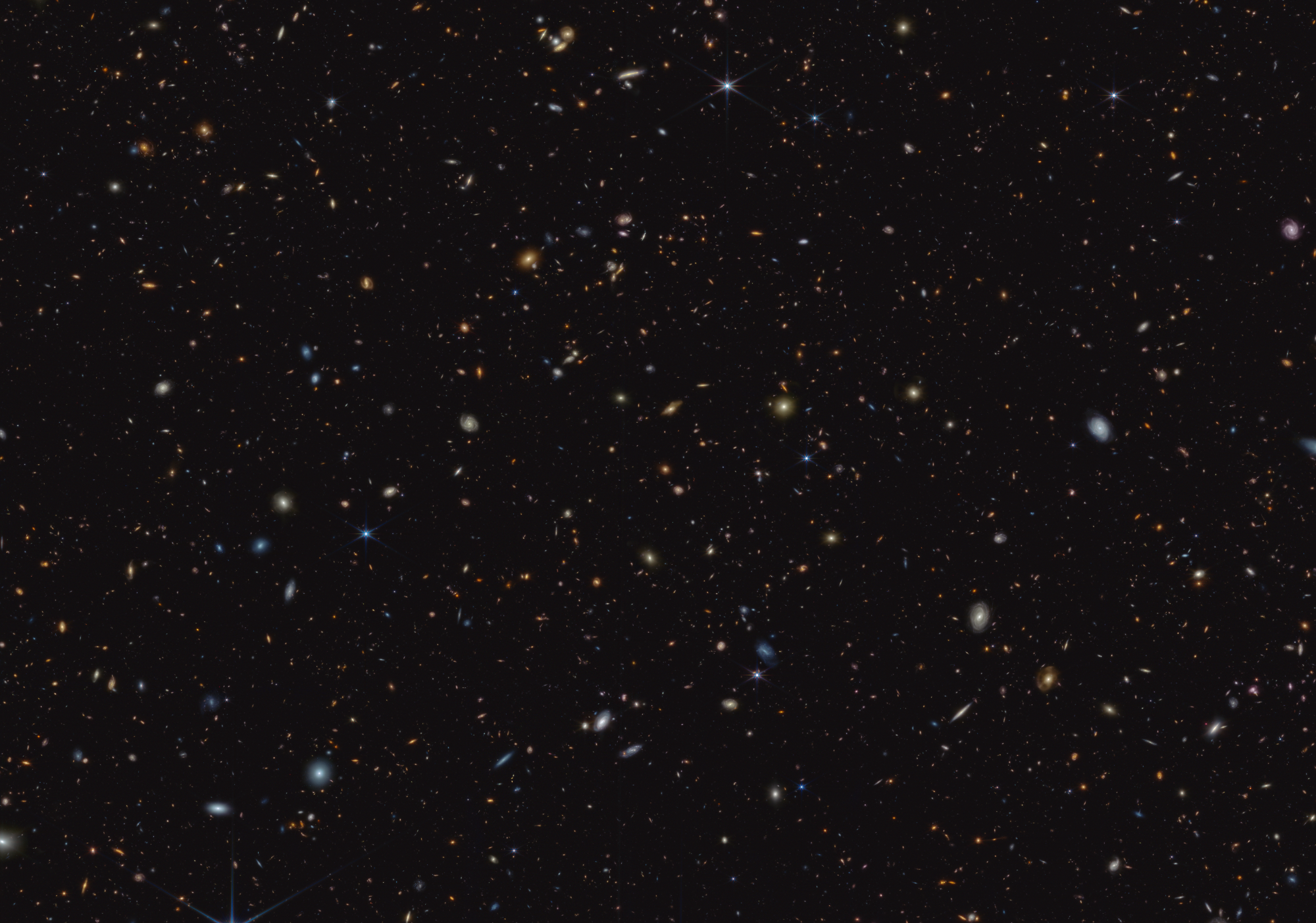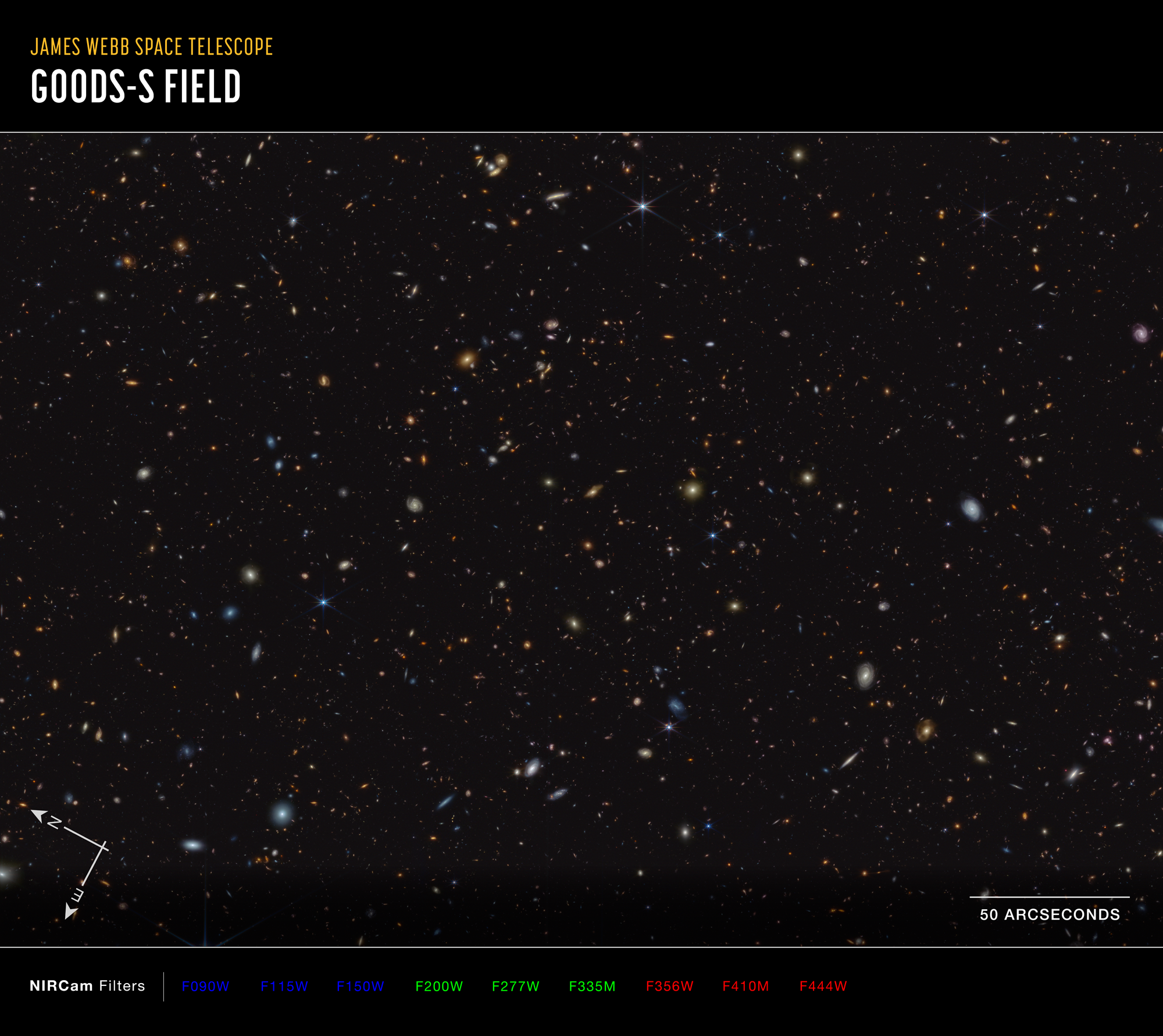
The James Webb Telescope (JWST or Webb) has unveiled hundreds of ancient galaxies that could be among the first members of the universe — a leap from only a handful that were previously known to exist at the time.
As early as 600 million years after the Big Bang, these very young galaxies flaunted complex structures and clusters of star formation, a new study reports. The study is part of an international collaboration called the JWST Advanced Deep Extragalactic Survey (JADES), which gathered a month's worth of observations from two tiny patches in the sky: One in the Ursa Minor constellation and another in the direction of the Fornax cluster. Within this region were over 700 newly discovered young galaxies that reveal with the cosmos looked like in its earliest
"If you took the whole universe and shrunk it down to a two hour movie, you are seeing the first five minutes of the movie," Kevin Hainline, an assistant research professor at the Steward Observatory in Arizona and a lead author of the new study, said while announcing the discovery on Monday (June 5) at the 242nd meeting of the American Astronomical Society being held in Albuquerque and online. "These are the galaxies that are starting the process of making the elements and the complexity that we see in the world around us today."
These new findings shed light on how the first galaxies and stars formed, creating the rich catalog of elements observed in the universe today.
Related: James Webb Space Telescope (JWST) — A complete guide
In those five minutes alone, which marks the universe to be between 370 million and 650 million years old, Hainline's and his colleagues studying Webb's data found 717 young galaxies — which turns out to be higher than previous predictions — with all of them already spanning thousands of light-years, sporting complex structures, and birthing stars in multiple clusters.
"Previously, the earliest galaxies we could see just looked like little smudges. And yet those smudges represent millions or even billions of stars at the beginning of the universe," Hainline said in a statement. "Now, we can see that some of them are actually extended objects with visible structure."
Together, the two regions used in this study are referred to as GOODS-South, an acronym for The Great Observatories Origins Deep Survey, and have been extensively studied by nearly all major space telescopes, including Hubble, the Chandra X-Ray Observatory and NASA's now-retired Spitzer.
Despite this previous scrutiny, 93% of the newfound galaxies that Webb spotted during JADES had never been seen before.

"What we were seeing before were just the brightest, most extreme examples of bright galaxies in the early universe," Hainline said during his presentation on Monday. "Now we are really probing down to more normal, everyday galaxies in a turbulent young universe."
Precisely how that chaotic, very dusty environment cleared up to become the transparent cosmos we see today has long been debated. A leading theory is that this phase of evolution of the universe, called the Epoch of Reionization, occurred some 400,000 years after the Big Bang, when the first generation of stars — thought to be 30 to 300 times our sun's mass and millions of times more bright — formed and flooded the opaque universe with its first light.
That ultraviolet starlight reionized the universe by splitting its abundant hydrogen atoms into protons and electrons, a process that lasted until one billion years after the Big Bang. However, few astronomers say outflows from supermassive black holes, similar to the one that resides in the heart of our Milky Way, could have triggered the escape of ultraviolet radiation from galaxies and thus played a more important role in cosmic evolution than previously thought.
Now, a second team from the JADES program that has been studying galaxies that existed between 500 to 850 million years after the Big Bang, or between five to eight minutes of the two-hour movie describing the universe, thinks it has an answer to the long-standing question.
"In this next scene of the universe, we are starting to actually see the impact of galaxy formation on the composition of the large scale universe," Ryan Endsley, a postdoctoral researcher at the University of Texas who led the second study, said at the news conference on Monday. "Galaxies in the very early universe were just far more chaotic in general in how they formed stars."
Endsley's team studied the signs of star formation in those very early galaxies, which provided insight into how starlight ionized the gas within those galaxies. The team found that one in six galaxies at the time showed extreme line emissions in the galaxy's spectra, a feature that atoms ionized by starlight radiate when they have cooled down and combined with other molecules.
Those emission lines are evidence that early galaxies were actively birthing stars, which then pumped "torrents of ultraviolet photons" into their respective galaxies. This way, the universe's early stars became the main drivers of cosmic reionization, Endsley said.
"These extreme emission lines are actually relatively common in the very early universe," he said during his presentation. "Almost every single galaxy that we are finding shows these unusually strong emission line signatures indicating intense recent star formation," he added in the statement. "These early galaxies were very good at creating hot, massive stars."
From the same emission lines, Endsley's team also inferred that galaxies in the early universe birthed stars in short bursts followed by quiescent periods.
"All of a sudden you would have tens of suns worth of solar masses being assembled all at once in these early galaxies," Endsley told reporters at the news briefing on Monday. "That's really important for our understanding of how reionization happened because these hot massive stars were very efficient producers of these ultraviolet photons that we needed in order to ionize all the hydrogen in the early universe."







